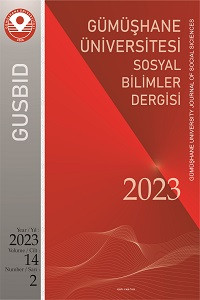Alternative Analysis of the Economic Outlook: Social-Oriented and Individual-Oriented Political Economy Approach
Abstract
How should the macroeconomic outlook be interpreted for individuals and the population? This study is developing an alternative macroeconomic performance measurement approach by proportioning the selected macroeconomic indicators to the population. This provides data on the individual-oriented cumulative outcome of economic management's decision-making and implementation processes. Also, it would show the gains/costs faced by individuals depending on the economic outlook. The crises encountered in the 21st century bring up debates on change/transformation in the roles/functions of states and public authorities at national/global scales.The second aim is to compare the macroeconomic performances measured based on both GDP and per capita macroeconomic indicators of countries.In accordance, the macroeconomic performances of 33 developed and developing countries for the 2000-2021 period were examined with the MOORA.The performance of the countries analyzed is based on both GDP and population-proportioned indicators (per capita). Thus, the similarities and/or differences between both macroeconomic performance measures are determined.In addition to emphasizing the individual-centered performance approach by dividing the population, the study also provides the indirect addition of an external indicator.The measurement style of the indicator of the GDP scores is called the Social-Centred Welfare Index and the indicator of the scores per capita is called the Individual-Centred Welfare Index.
Keywords
Per-Capita Indicators MOORA comparative political economy economic outlook macroeconomic performance
References
- Acemoğlu, D., & Restrepo, P. (2017). Secular stagnation? The effect of aging on economic growth in the age of automation. American Economic Review, 107(5), 174-179.
- Adrangi, B., & Kerr, L. (2022). Sustainable development indicators and their relationship to GDP: Evidence from emerging economies. Sustainability, 14(2), 658.
- Angus, M. (1983). A comparison of levels of GDP per capita in developed and developing countries. The Journal of Economic History, 43(1), 27-41.
- Armstrong, H., De Kervenoael, R. J., Li, X., & Read, R. (1998). A comparison of the economic performance of different micro-states, and between micro-states and larger countries. World Development, 26(4), 639-656.
- Banister, J., Bloom, D. E., & Rosenberg, L. (2012). Population aging and economic growth in China. The Chinese Economy, 114-149.
- Brauers, W. K. (2013). Multi-objective sea port planning by MOORA decision making. Annals of Operations Research, 39-58.
- Brauers, W. K., & Zavadskas, E. K. (2006). The MOORA method and its application to privatization in a transition economy. Control and cybernetics, 35(2), 445-469.
- Creedy, J., & Moslehi, S. (2009). Modelling the composition of government expenditure in democracies. European Journal of Political Economy, 25(1), 42-55.
Abstract
Makroekonomik görünüm bireyler ve nüfus açısından nasıl yorumlanmalıdır? Bu çalışmanın ilk amacı, seçilen makroekonomik göstergeleri nüfusa oranlayarak alternatif bir makroekonomik performans ölçüm yaklaşımı geliştirmektir. Böyle bir yaklaşım, ekonomi yönetiminin karar alma ve uygulama süreçlerinin bireysel odaklı kümülatif çıktıları hakkında veri sağlayacaktır. Değerlendirme, ekonomik duruma bağlı olarak bireylerin karşılaştıkları kazançlarını/maliyetlerini gösterebilecektir. 21. yüzyılın ilk ve ikinci on yıllarında yaşanan krizler, ulusal ve küresel ölçekte devletlerin ve kamu otoritelerinin rol ve fonksiyonlarındaki değişim ve dönüşüm tartışmalarını gündeme getirmektedir. Çalışmanın ikinci amacı ise hem GSYH hem de kişi başına düşen makroekonomik göstergeler bazında ölçülen makroekonomik performansların ülkeler bazında karşılaştırılmasıdır. Çalışmanın amaçları doğrultusunda seçilen 33 gelişmiş ve gelişmekte olan ülkenin 2000-2021 dönemi makroekonomik performansları MOORA ile incelenecektir. Ülkelerin performansı, hem GSYH hem de nüfusa oranlı göstergeler (kişi başına olarak tanımlanır) temelinde analiz edilecektir. Böylece her iki makroekonomik performans ölçümü arasındaki benzerlikler ve/veya farklılıklar belirlenebilecektir. Çalışma, verileri nüfusa oranlayarak birey merkezli performans anlayışını vurgulamanın yanı sıra, makroekonomik performansta yer almayan bir dış göstergenin dolaylı olarak ölçüm sistemine eklenmesini de sağlamaktadır. Bu çalışmanın ölçüm biçimi Sosyal Merkezli Refah Endeksi olarak adlandırılan GSYH skorlarının göstergesi iken, kişi başına düşen skorların göstergesi Birey Merkezli Refah Endeksi olarak adlandırılmaktadır.
Keywords
Kişi başına düşen göstergeler karşılaştırmalı ekonomi politik ekonomik görünüm makroekonomik performans MOORA
References
- Acemoğlu, D., & Restrepo, P. (2017). Secular stagnation? The effect of aging on economic growth in the age of automation. American Economic Review, 107(5), 174-179.
- Adrangi, B., & Kerr, L. (2022). Sustainable development indicators and their relationship to GDP: Evidence from emerging economies. Sustainability, 14(2), 658.
- Angus, M. (1983). A comparison of levels of GDP per capita in developed and developing countries. The Journal of Economic History, 43(1), 27-41.
- Armstrong, H., De Kervenoael, R. J., Li, X., & Read, R. (1998). A comparison of the economic performance of different micro-states, and between micro-states and larger countries. World Development, 26(4), 639-656.
- Banister, J., Bloom, D. E., & Rosenberg, L. (2012). Population aging and economic growth in China. The Chinese Economy, 114-149.
- Brauers, W. K. (2013). Multi-objective sea port planning by MOORA decision making. Annals of Operations Research, 39-58.
- Brauers, W. K., & Zavadskas, E. K. (2006). The MOORA method and its application to privatization in a transition economy. Control and cybernetics, 35(2), 445-469.
- Creedy, J., & Moslehi, S. (2009). Modelling the composition of government expenditure in democracies. European Journal of Political Economy, 25(1), 42-55.
Details
| Primary Language | English |
|---|---|
| Journal Section | Articles |
| Authors | |
| Publication Date | June 12, 2023 |
| Submission Date | February 17, 2023 |
| Published in Issue | Year 2023 Volume: 14 Issue: 2 |



